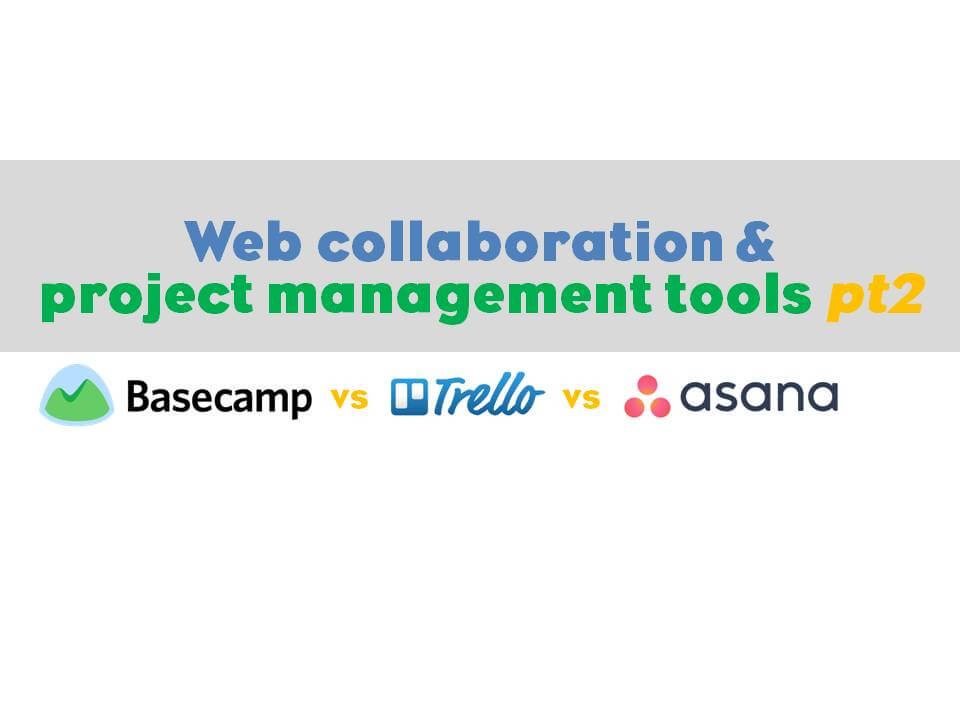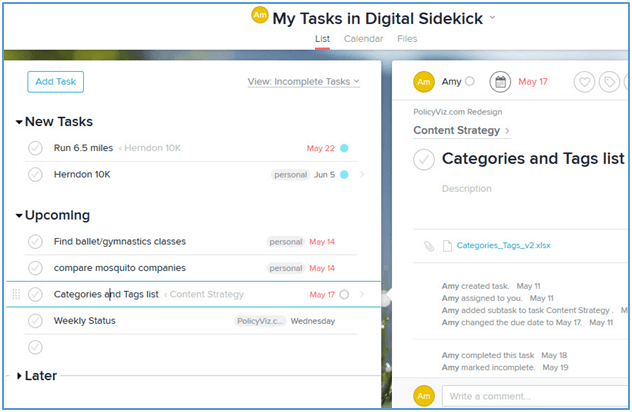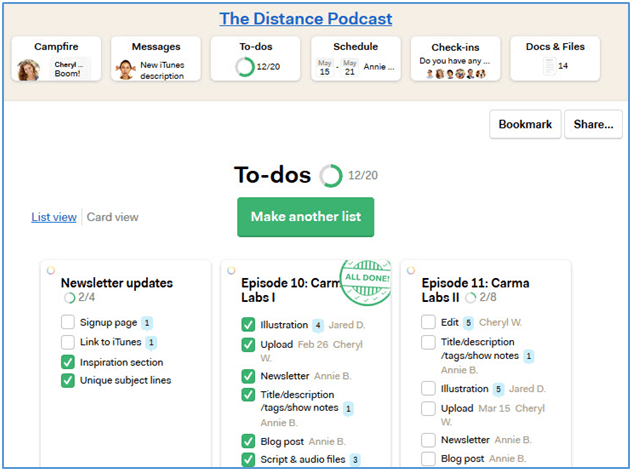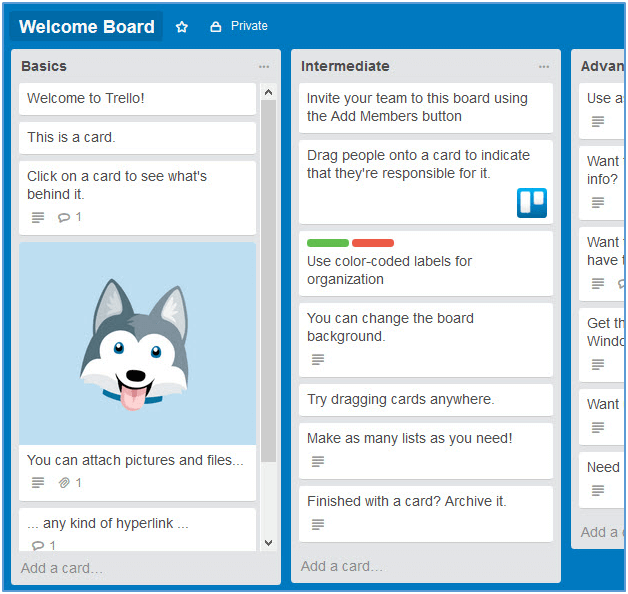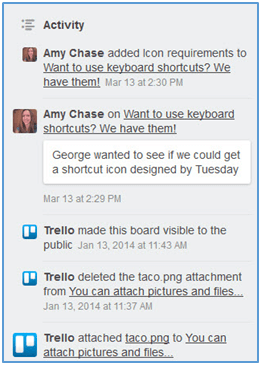In March I wrote about the wide field of online collaboration tools. I promised a deeper dive into my favorite group of those tools, those focused on project management. Having tested out Asana on a full-fledged client project, revisited Basecamp, and continued work in Trello, I am ready to share my notes and votes!
The Products
Both Asana and Basecamp have been significantly updated in the last year or so, so if you have old experience with them, you should return to check out the changes. If you read other blogs comparing products, look at their publish dates!
As I mentioned in my previous post, I was a big fan of the original Basecamp when I used it back in 2006 or so. Basecamp 2 became available in 2012 and Basecamp 3 in 2015. You cannot start a new Basecamp Classic account, but existing users can continue with it. Basecamp 2 and 3 are separate entities, and, while Basecamp 3 is promoted more, you can still create a new account in Basecamp 2. My time exploring Basecamp this go-around was spent in the latest version.
The updated Asana, released in 2015, very recently had an option to click over to the original version, but I believe they just took that away. When writing this post I attempted to re-find that option to no avail.
Trello does not appear to have released any major updates since its initial launch in 2011. This may be part of what I like about it. It is focused on practical functionality.
All three tools are a quick learn and come with lots of training, some of which is presented as you work in the tool and some which you can go read on their guides. They also all offer ongoing tips, case studies, and blogs to help you take full advantage of the product.
A Basic Comparison
Basecamp and Asana are, from my viewpoint, very similar in their features and feel. They are structured based on their features. For example, Basecamp and Asana both have conversation sections (Basecamp actually breaks this down into a chat board called “Campfire” and longer format conversations called “Messages”), task/to-do sections, and file sections. Additionally Asana has a “progress” section to share regular status notes and Basecamp has an “automatic checkins” section to regularly poll the team on whatever topic you’d like.
Trello is different. It is structured as boards, lists, and cards, essentially functioning like a clean row of sticky notes. When you flip the post-it (in Trello, the “card”) around, it can contain tasks, checklists, files, etc.
The Trello wikipedia page claims its basis in Kanban, the just-in-time manufacturing and team involvement/progress methodology first championed at Toyota. Regardless, it is very simple and intuitive. And it is my top choice out of these three tools.
Why I Prefer Trello
Trello allows you to focus on the content and deliverables of your project giving you the freedom to structure a workspace around that project’s unique components. And it feels clean and simple.
A major frustration for me in Asana or Basecamp is that there are too many tools—too many places where someone might deposit their content or feedback. This means work for the team to follow all the little pieces of a conversation. Since easily finding information is one of the main motivators to employ one of these tools, any hiccups in that department are significant. I’m sure having some rules in place for how your team uses any of these tools would help keep things consistent and easy to find. Trello, however, had me more naturally working in the right spaces.
Trello (like Basecamp) automatically shows a log of the most recent activity making it easy to sign in and get a sense of who updated what since your last visit. This is more buried in Asana.
And Trello is more likely to remain free for organization than the freemium Asana or “only one project for free” Basecamp. More on that in a moment, but first let me step back.
Try Them Out
Unfortunately my liking Trello doesn’t mean it’s the best bet for you. There’s a lot of personal preference that will determine which is the right tool for you and your team, plus, for you, certain features and upgrades may be crucial enough to steer your decision.
Trello and Asana are both very easy to immediately try for free. Trello offers unlimited users and unlimited boards (each project lives on a separate board) for no fee. Asana offers unlimited projects and up to 15 users with no fee. Basecamp is harder to test out; they allow you one free project plus an example project in which to play around. I didn’t read the fine print and set up my first project without as much care as I would have had I realized it was my only go at a free Basecamp.
Fees
The short story for staying free is…
- Trello is free for as many users as you need until you need to upload bigger files.
- Asana is free until you need more than 15 members participating.
- Basecamp is free until you need a second project.
- Basecamp doesn’t get more expensive as you add more users, Asana does.
Here’s the longer scoop.
Trello
Trello will charge you to upgrade to Gold if you need to upload files larger than 10MB. That’s $5/month/user to allow files up to 250MB, and can be added for just one or a few users. You can get Gold for free if you refer a couple new users to Trello.
Trello also offers Business for $8.33/month/user which increases your file size allowance plus opens up integrations with other tools, adds some over-arching admin views, and augments board privacy options, like restricting who can make private boards. My understanding is that this would need to be purchased for the whole team.
Trello’s Enterprise product is $20.83/month/user and adds a lot of professional support and training plus richer security like 2-factor authentication.
Asana
Asana requires a move to Premium and begins charging you per user once you surpass 15 team members. They list $8.33/month/user but disclose the rate is higher if you have bigger teams, up to $10/month/user. There are some more nuances to the Premium setup, like you can upgrade just a team within your organization rather than everyone. Like Trello Business, Asana Premium also comes with additional privacy options. And when you upgrade your whole organization to Premium, you get additional admin controls and, and like Trello Enterprise, extra professional support and training.
Basecamp
As one project is really just for testing things out, you know you’ll have to pay for Basecamp. They charge $29/month (total—not per user) or $79/month if you want their Basecamp With Clients privacy features.
GUEST BLOGGER, AMY CHASE
Amy Chase is a freelance digital strategist and project manager and a friend of Williams Whittle. Her company Digital Sidekick, LLC, is based in the Washington, DC area serving clients across the country. In her many years at agencies and in her own practice she has enjoyed projects with clients from healthcare to education to government and beyond. Amy is motivated by making people’s lives easier through her work, both by facilitating smooth projects and via the products she helps create. You can find her on LinkedIn.
